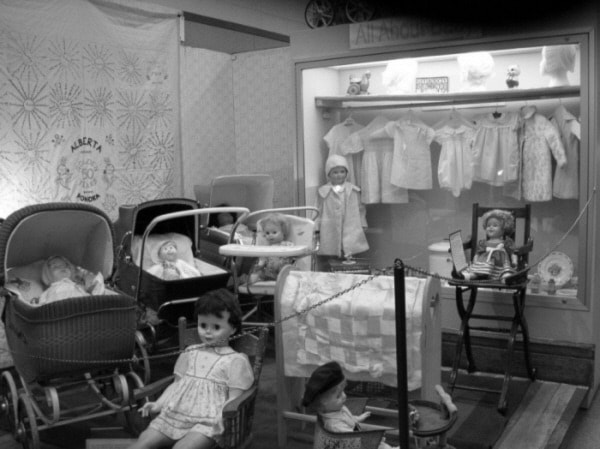Whether the little boys thought that it was a sissy thing or not, little girls have been dressing, cuddling, pampering, and playing with the dolls since the beginning of time. Dolls of all sizes, shapes, personalities and nationalities have been life-like companions for generations of families, and even though their habits, their appearance and their cute little tricks may have changed just a little over the years, they have and always will be a special and joyful part of every little girl’s growing up world.
Dolls and puppets first appeared on the scene way back in 2000 B.C. when the Egyptians carved and fashioned crude figures made out of wood, clay, bone, and rock. These were hand painted and decorated with designs, symbols, and trinkets, and then placed on the graves to honour their leaders, their heroes, and their gods. As little girls started to discover the magic of dolls, they were mass produced from the 1400s on, along with the countless colorful and delicate accessories that instantly became a delightful play time part of every home.
Two new displays at the Fort Ostell Museum
The congenial ladies at the Fort Ostell Museum in the Ponoka Lions’ Centennial Park have just completed two amazing displays of early dolls and puppets as well as a special section that is ‘All about Baby’. The latter features some of the unique prams, carriages, cribs, outfits and all the rest that were required to bring up generations of little duffers from birth to rambunctious youngsters, while the doll showcase includes characters of all ethnic and entertainment back-grounds, and are dressed in various costumes of those exciting times of days gone by. The rare and colorful collection is a must see for all ages, and will certainly bring back a lot of memories, chuckles, and maybe even a few tears; and here are just a few of the highlights from the fun era where kids somehow survived without Barbie or Pampers.
• Popeye the Sailor Man was created by Elzie Segar and first appeared in comic strips in 1929. One of the most collectible characters in the world of comics, the powerful spinach chomping Popeye appears in the Ponoka display with his chatty girlfriend Olive Oyl.
• One of the oldest forms of performance and entertainment was the art of puppetry, with the first string operated characters appearing in Egypt as early as 2000 B.C. The Fort Ostell museum display shows several Marionettes, which were manipulated from above, allowed an amazing freedom of movement, and demanded extreme skills by the people who were pulling the strings.
• The first bisque porcelain dolls became very popular in 1860, and featured a realistic skin color and texture as well as the first movable head and jointed body.
• Kewpie Dolls were first created in 1909 for use in comic strips, but became so popular they were introduced as a line of delightful baby cupid doll characters. Created in bisque, hard plastic, vinyl, and soft rubber, they were still a cuddly item into the 1990s.
• What can we say about the infamous ‘rag dolls’, which have been traditionally made from spare household scraps for countless decades? Since the early 19th century, these simple but loveable characters have lived on for many years in such delightful children’s stories as Raggedy Ann, Golliwogg, and Anne of Greene Gables, a doll of which now has a permanent home at our Fort Ostell Museum, complete with long flowing braids.
• Have you ever heard of a composition doll? They first appeared in the early 19th century, were made out of a composite material of sawdust, glue, cornstarch, resin, and wood flour, and were marketed as completely unbreakable, which I find unbelievable when it comes to the overwhelming energy of little girls and boys.
• Some of the most beautiful and exclusive ‘antique dolls’ were first made by Heinrich and Minna Handwerck in Gotha, Germany in 1876. Outstanding features included big almond shaped eyes, ball-jointed composition body and fabulous costumes, which is a treat to see.
• A young art student by the name of Xavier Roberts used an old German technique to mold fabric with a needle and created the first line of dolls called ‘The Original Little People’. His concept featured delightful little characters, of which there were no two alike, came with their own birth certificates and name tags, and whom excited customers could adopt (not buy) their very own sculptured person for $30.00. The lucrative toy company, which opened a Babyland General Hospital in Cleveland in 1979, would also introduce ‘The Cabbage Patch Kids’ and many more very popular and lifelike characters over the years.
• Fisher Price began making a series of dolls during the 1970’s that they called ‘My Friend’. Over the years there would be Mandy and Jenny, who stood 16 inches tall, had rooted hair, and included a long line of outfits that had to be purchased separately in the large size.
• Most of the items in these new displayed have been kindly donated by families and individuals families from Ponoka and surrounding districts, and many of them were fashioned by members of the family, and have lasted for many generations. There is even a handmade door stop with a ceramic head and a stuffed body, as well as a unique homemade doll delicately made out of multi-circles of fabrics and joined together.
• As you look through the ‘All about Baby’ display watch for the original wood rattle, those fluffy cloth diapers with the big safety pins, an old bath tub duckie, eating utensils and dishes with pictures, a bottle of castor and ZBT Baby Powder, toys, fancy hand-knit outfits, and much more. During your visit, don’t be afraid to ask questions, and please take some quality time to browse through a facility that is dedicated to our long and colorful history and heritage.
